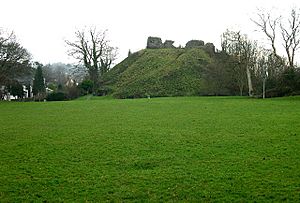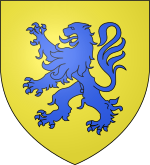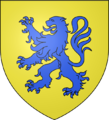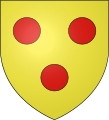Feudal barony of Plympton facts for kids

The feudal barony of Plympton was a very large area of land in Devon, England. It was like a mini-kingdom ruled by a powerful lord. Its main center, called its caput, was Plympton Castle and the nearby manor (a large estate) of Plympton. This barony was one of eight similar large landholdings in Devon during the Middle Ages. It also included an area called the Honour of Christchurch in Hampshire (now Dorset). The first family to own this barony was the de Redvers family. They were also the Lords of the Isle of Wight. However, the Isle of Wight lordship was later sold to the king by the last de Redvers owner, Isabel de Redvers, 8th Countess of Devon (who lived from 1237 to 1293). This meant the Courtenay family, who later inherited Plympton, did not get the Isle of Wight.
Contents
How the Barony Began
Early Owners in the Domesday Book
Many of the lands that later became part of the Plympton barony were first owned by two important people after the Norman Conquest. These were Robert d'Aumale and William de Poilley. They were direct tenants of King William the Conqueror (who ruled from 1066 to 1087). The Domesday Book of 1086, a famous survey of England, lists 17 entries for Robert d'Aumale's lands. He was a lord from Aumale in Normandy, France.
Who Owned the Barony Over Time
The ownership of the Plympton barony passed down through different families. This is called its "descent."
The de Redvers Family
- Richard de Redvers (died 1107): King Henry I (1100–1135) gave Richard this barony and many other estates. Richard was a very trusted friend of the king. Before this, these lands belonged directly to King William the Conqueror.
- Baldwin de Redvers, 1st Earl of Devon (died 1155): Richard's son. He was made the first Earl of Devon by Empress Matilda during a time of civil war called The Anarchy.
- Richard de Redvers, 2nd Earl of Devon (died 1162): Baldwin's son.
- Baldwin de Redvers, 3rd Earl of Devon (died 1188): Richard's son. He died without having any children.
- Richard de Redvers, 4th Earl of Devon (died around 1193): Baldwin's brother. He also died without children.
- William de Redvers, 5th Earl of Devon (died 1217): The uncle of the previous two Richards.
- Baldwin de Redvers, 6th Earl of Devon (1217–1245): William's grandson. He was too young to rule when his grandfather died. So, the king gave control of the barony to Falkes de Breauté (died 1226) in 1218. Falkes married Baldwin's mother. However, Falkes's lands were taken away in 1224. The barony stayed with the king until Baldwin became an adult in 1238.
- Baldwin de Redvers, 7th Earl of Devon (1236–1262): Baldwin's son. He died without children.
- Isabel de Redvers, 8th Countess of Devon (1237–1293): Baldwin's sister. She married William de Forz, 4th Earl of Albemarle (died 1260) when she was young. Sadly, all six of her children died before her. When she died in 1293, the Plympton barony and eventually the Earldom of Devon went to her younger cousin, Hugh de Courtenay (1276–1340). He was already the feudal baron of Okehampton in Devon. In 1335, he was officially declared the Earl of Devon.
The Courtenay Family

- Robert de Courtenay (died 1242): He was the feudal baron of Okehampton. He married Mary de Vernon, who was the daughter of William de Redvers, 5th Earl of Devon (died 1217). Because of this marriage, the Courtenay family later inherited the Plympton barony in 1293. They were then declared Earls of Devon in 1335.
- John de Courtenay (died 1274): Robert's son. He married Isabel de Vere.
- Sir Hugh de Courtenay (died 1292): John's son. He married Eleanor le Despenser.
- Hugh Courtenay, 9th Earl of Devon (1276–1340): Hugh's son. When his cousin Isabel de Forz died in 1293, he became the heir to the Plympton barony. In 1335, he was declared the Earl of Devon. From then on, the ownership of the Plympton barony followed the line of the Earls of Devon.
However, in 1539, King Henry VIII took control of the barony's lands. He had Henry Courtenay, 1st Marquess of Exeter (died 1539) executed for treason. This meant the Earldom of Devon was lost, and the Courtenay lands went back to the crown.
Images for kids
Sources
- Pole, Sir William (died 1635), Collections Towards a Description of the County of Devon, Sir John-William de la Pole (ed.), London, 1791, pp. 6–11, Plimton
- Sanders, I.J. English Baronies: A Study of their Origin and Descent 1086–1327, Oxford, 1960, pp. 137–8, Barony of Plympton
- Thorn, Caroline & Frank, (eds.) Domesday Book, (Morris, John, gen.ed.) Vol. 9, Devon, Parts 1 & 2, Phillimore Press, Chichester, 1985, chapter 1,17





